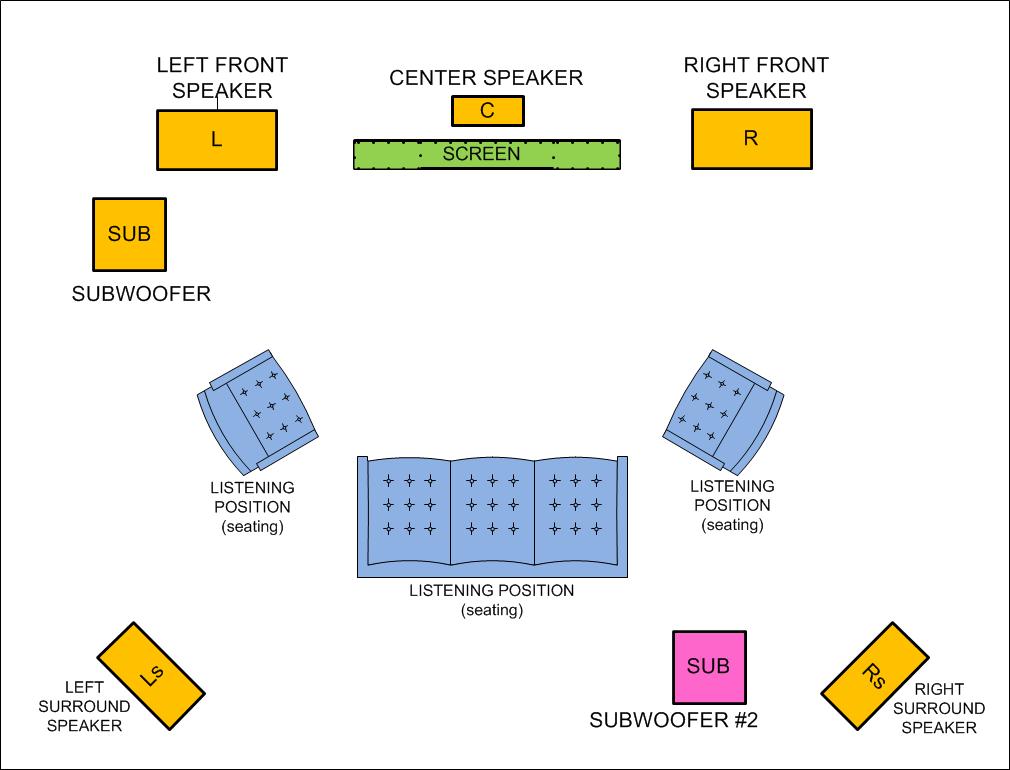 This Subwoofer Guide will provide what you need to know about subwoofers for Home Theater.
This Subwoofer Guide will provide what you need to know about subwoofers for Home Theater.
This guide includes how subwoofers work, what types will work best in your listening room, and how to set it up once you have it in your hands.
If you’re looking for our picks check out our Best Subwoofer Choices.
Types of Subwoofers:
Subwoofers for Home Theater are available in two types of systems: powered (called active) and non-powered (called passive). There are others types available such as Passive Radiators but their popularity is waning lately so this Subwoofer Guide will not be discussing them.
Active Subwoofers: These subwoofers are the most favored types these days, and pretty much your best choice for us in Home Theater systems. A standard active subwoofer includes an amp, a crossover frequency dial, phase dial or switch, and input connectors. You’ll need an open power receptacle to plug it in as well.
Using the crossover control gives you the ability to change the range of frequencies your subwoofer reproduces and sets the frequencies to be filtered out. The phase switch allows you to integrate the subwoofer with your other speakers. To set it correctly, you’ll need to listen to it in multiple positions (0 degrees and 180 degrees from it) to see where it gives you the deepest bass impact.
Passive or Unpowered Subwoofers: Passive subwoofers are made to be powered with an amp. The amp might be dedicated separate amplifier or from the speaker terminals of the receiver. The amp’s power should be high enough to reproduce the deep bass you’re looking for. Look for a few hundred watts at the very least.
Subwoofer Features to Consider
Automatic on and off: This will allow the subwoofer to sense when there is a signal and automatically turn on. It would then turn off once no signal is detected, usually after 5 minutes or so. It should be noted however that the subwoofer amplifier, even in its auto-off position may still use some power. There should be a master power switch that I suggest you use if you don’t plan on using the sub for awhile.
Downward Firing: With this type, the woofer is installed in the bottom and it fires down towards the floor. Down-Firing subwoofers usually appear just like another piece of furniture. Ideally you do not want to place this type of subwoofer in the corner of a room or it will sound boomy and lack the tight-bass you’re after.
Front/Forward Firing: The woofer is mounted to one of the sides and the sound is output across from the floor. Front or Forward-Firing subwoofers will usually have a grill covering the woofer and it looks like a large box-speaker.
Sealed Enclosures:. This will have the woofer located on one side of a completely sealed box. The air tight box isolates the back wave of the woofer from the front. The sealed enclosure provides great transient response, efficient power handling at low frequencies, smaller box size, and a much lower sensitivity.
Ported Enclosure: An additional open port which allows the passage of air is added to these boxes. At lower frequencies, the port contributes to the output and makes the system more efficient. These subwoofers typically have lower distortion and higher power handling. Ported subwoofers are more sensitive to non-aligned parameters than sealed enclosure systems, making constructing them a bit more difficult.
These last descriptions of types in this subwoofer guide may not help you to choose which type is right for you if you haven’t auditioned many in a proper listening environment. To help a bit with that; Typically a ported enclosure will fit within more budgets but give up a small amount in accuracy and tightness in bass response.
If you’re looking for our picks check out our Best Subwoofer Choices.
Woofer (Driver) Size: Subwoofers consist of some of the largest drivers around mainly due to the fact that they’re responsible for moving large amounts of air to recreate low frequencies. For every octave drop you will need to have 4x the output to get the same level. Typical subwoofer sizes are 8″, 10″, 12″, and some at 15″. A larger woofer is not always the best way to get great deep, clean bass. It’s more essential that the woofer is designed accurately to keep it in its linear range while moving mass amounts of air. These small driver subwoofers usually will require a higher power amp to make a long-throw woofer produce acceptable performance in such a small-sized box.
Here is the absolute minimum power we recommend in this subwoofer guide for your home theater subwoofer:
8″ woofer – 50 minimum watts
10″ woofer – 75 minimum watts
12″ woofer – 100 minimum watts
15″ woofer – 150 minimum watts
How To Install:
For receivers with a subwoofer output simply use a standard RCA cable from the receiver to the subwoofer input. Please don’t use a cheap cable (under $1). Every modern day receiver I’ve seen has this type of output available. I suggest Monoprice.com for all your cable purposes. They offer a lifetime warranty and are easy to work with in case the need arises for a replacement. Their cables will work perfectly with the options discussed in this subwoofer guide.
For those receivers without a subwoofer output, but with extra Pre-Outs, you can use a set of stereo RCA cables from the Pre-Outs of the receiver to the Left and Right Inputs on the powered subwoofer.
Adjustments
OK, with this subwoofer guide we’re after the kind of bass you can actually feel, not just hear. Not boomy bass, but clear, tight, deep bass like you hear at most movie theaters these days. Sometimes, based on the subwoofer’s location, you will have great bass from one seating location, and very low bass from another. You don’t want to turn the sub up louder to accommodate or you could end up with clipped sound or the driver bottoming out.
Ideally you should not be able to easily locate where the subwoofer bass is coming from.
Level Adjustment
We recommend using an SPL meter for level adjustment. If you don’t have an SPL meter, you can use the built-in calibration program of your receiver or simply use your own ears.
Be sure the subwoofer channel level is set to the same number on the SPL meter (or set by ear) as all the main speakers.
Where to Locate the Subwoofer
Your room and all the contents (furniture, carpet, windows, etc.) affect the sound of your entire audio system. Placing the subwoofer appropriately for your room will integrate it with your main speakers to give it a more natural sound.
In the Corner: Placement in the corner is only suggested if your subwoofer doesn’t produce much bass (even then it may be too boomy for you). It really depends on the room’s dimensions. Give it a try and see. Just remember it will take some time to determine the best corner, but this option is only a last resort in our opinion.
Near your Main Speakers: Bass, especially deep bass is typically not a directional sound, however if you place the subwoofer somewhat near your main speakers it may blend well. Depending on your room’s dimensions and acoustics, it may also sound well beside your listening position. We have ours directly next to the couch and it acts as an end-table and blends extremely well with the crossover set to the lowest level. While writing this subwoofer guide we tested alternate placement locations for our sub. In front of our listening position did provide a bit more bass response, but it also did not blend will with the decor in our living room, so we moved it back and still absolutely love it!
Should you have Two Subwoofers? Ideally if you have the budget for it, two subwoofers will give you the best balance and make room placement not as important. Having more than one subwoofer will reinforce each of their bass response and provide a more dynamic and smooth sound. If you go this route, you must use identical subwoofers or risk an uneven response.
Crossover Frequency Setting
The crossover frequency should be set on your AV Receiver and not the subwoofer itself. If your front speakers have a good bass response a good setting is 80Hz. For smaller speakers, satellites or in-wall models with a low bass response try a setting between 100Hz to 120Hz. According to the Recording Academy recommendations, using a frequency between 80 and 100Hz will produce the best results.
Begin the AV Receiver’s test tone generator/set-up/level-calibration between 30Hz to 200HZ and listen with your ears or measure with an SPL meter device. Adjust up or down the crossover frequency to get the smoothest response among all channels.
Subwoofer Phase Adjustment
As the subwoofer’s driver (or the other speaker’s) move in and out of sync, the system is said to be in phase. When out of sync with each other, the subwoofer and other speaker’s bass may overlap and cancel each other out (out of phase).
To get the best bass response, set the phase (polarity) of the subwoofer to deliver the highest output from where you are listening the most often. This should be done with the help of a test signal at the crossover frequency and an SPL meter (or just use your ears). Do the test multiple times by changing the polarity of the subwoofer and measuring the bass response on the SPL meter (or how you hear it with your ears). Set the phase option that gives you the highest amount of bass.
And there you have it! This Subwoofer Guide covered the very basics of their design and various types to choose from. If you’re looking for our picks check out our Best Subwoofer Choices.

